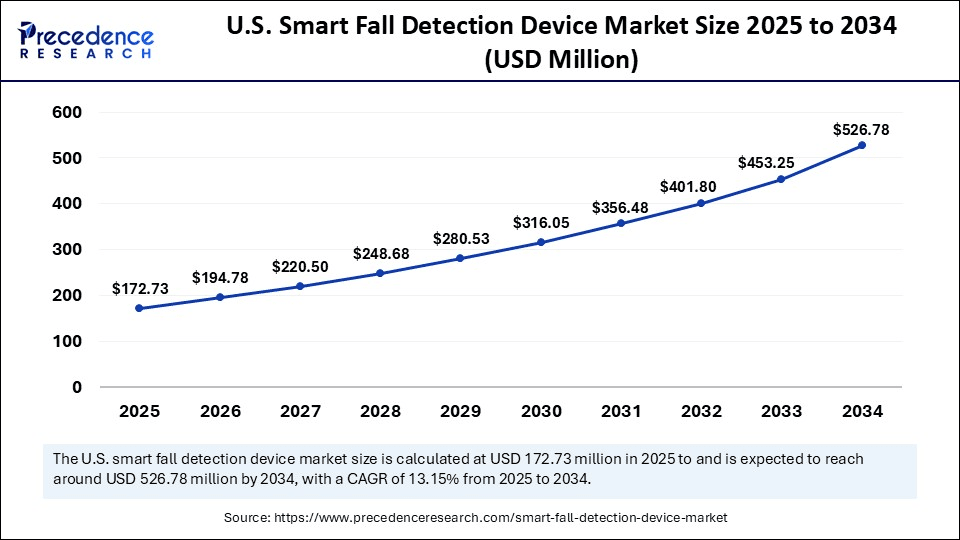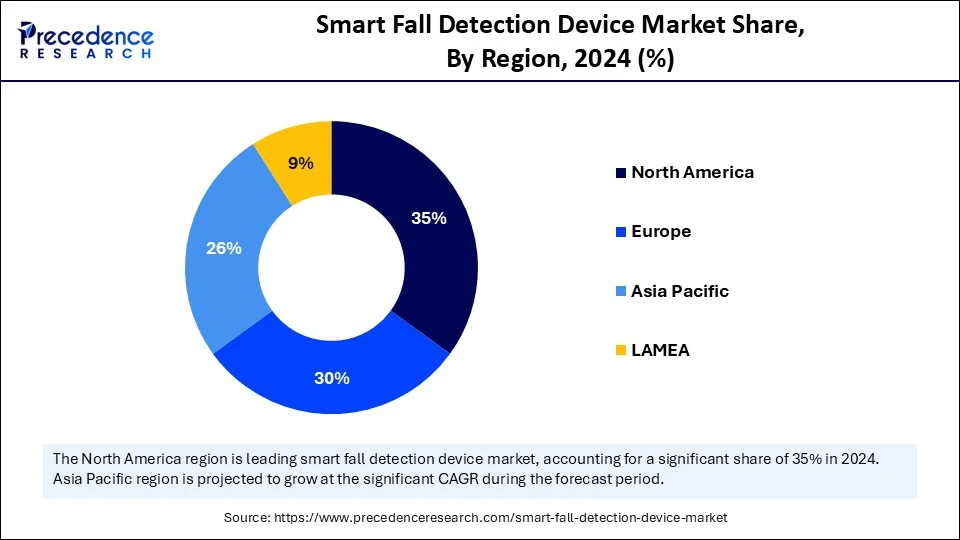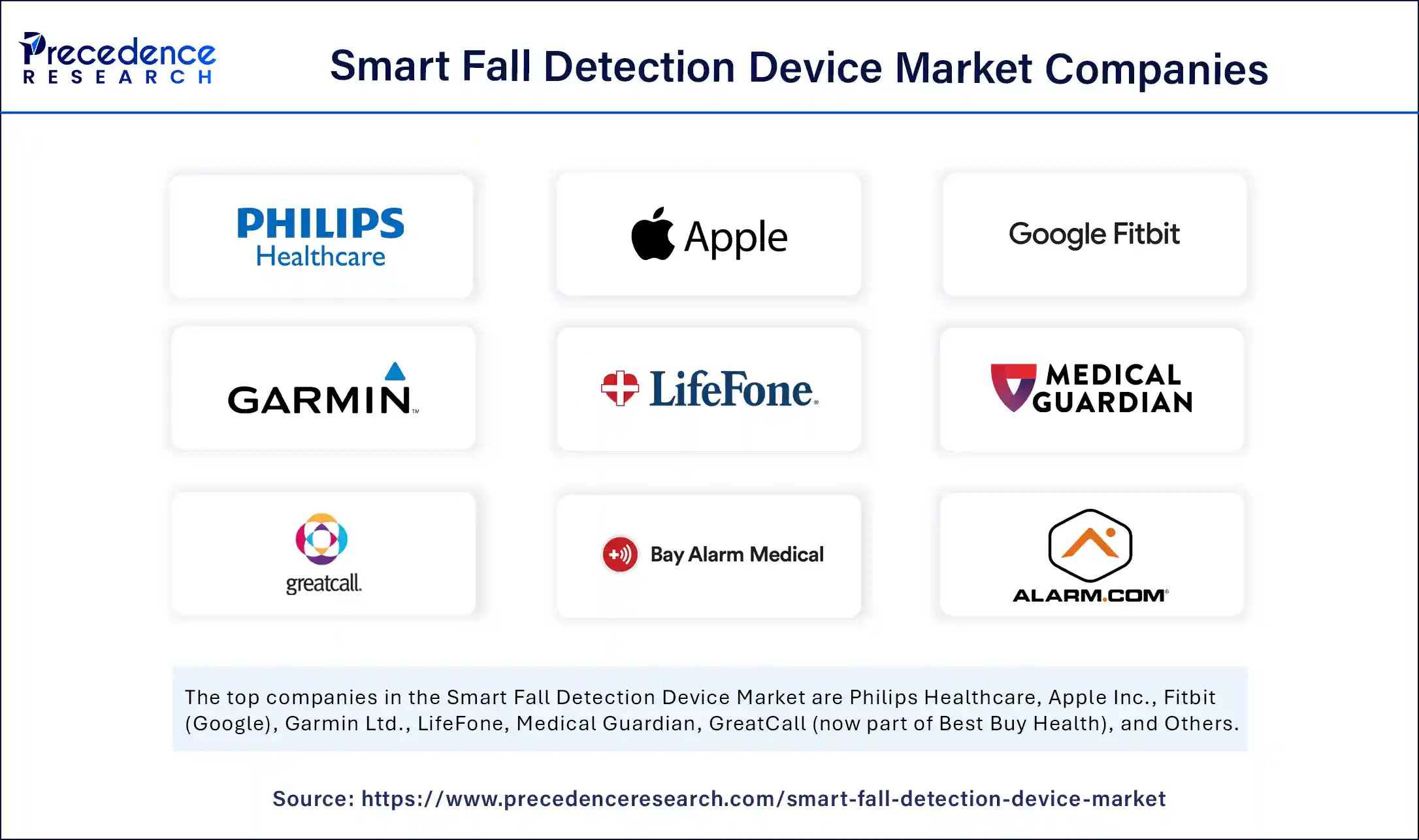Smart Fall Detection Device Market Size and Forecast 2025 to 2034
The global smart fall detection device market size was calculated at USD 1.25 billion in 2024 and is predicted to increase from USD 1.41 billion in 2025 to approximately USD 4.18 billion by 2034, expanding at a CAGR of 12.83% from 2025 to 2034. The market is significantly fuelling due to an increasing ageing population who need continues monitoring and postoperative care, advancement in sensor technology like IoT, AI/ML integration with fall detection devices, and enhanced awareness about preventive measures in the healthcare sector.

Smart Fall Detection Device Market Key Takeaways
- In terms of revenue, the global smart fall detection device market was valued at USD 1.25 billion in 2024.
- It is projected to reach USD 4.18 billion by 2034.
- The market is expected to grow at a CAGR of 12.83% from 2025 to 2034
- North America held the largest smart fall detection device market share of nearly 35% in 2024.
- Asia Pacific is expected to witness the fastest CAGR during the forecasted years.
- By product type, the wearable devices segment held the largest market share in 2024.
- By product type, the non-wearable devices segment is expected to witness the fastest CAGR during the forecasted years.
- By technology, the sensor technology segment contributed the highest market share in 2024.
- By technology, the communication technology segment is expected to witness the fastest CAGR during the forecasted years.
- By application, the personal health monitoring segment held the largest market share of nearly 50% in 2024.
- By application, the emergency response systems segment is expected to witness the fastest CAGR during the forecasted years.
- By end-user, the elderly care segment accounted for the highest market share in 2024.
- By end-user, the healthcare facilities segment is expected to witness the fastest CAGR during the forecasted years.
- By distribution channel, the online retail segment captured the biggest market share of 48% in 2024.
- By distribution channel, the direct sales segment is expected to witness the fastest CAGR during the forecasted years.
How is AI Transforming the Smart Fall Detection Device Market?
Artificial intelligence in healthcare has impacted many areas within it, among which fall detection devices have found extensive applications of AI systems. Falls in healthcare are a major issue, especially for those patients who are in the post-operative phase, severally ill, and have other issues related to bones or genetic disorders that make them highly susceptible to falls. Theus, an AI-based fall detection device, works on ML algorithms and advanced sensors connected to it, which detect patterns and irregularities in a certain healthcare parameter that are abnormal to identify possible falls and prevent them priorly. It also tracks patients' movement, activities, and instantly alerts caretakers or doctors, nursing staff, or whoever they are aligned with to send messages by analyzing the potential risk of falls. It further offers benefits like improved patient safety, boosting caregivers' confidence, working efficiency with immediate actions, and minimizing hospital stays.
U.S. Smart Fall Detection Device Market Size and Growth 2025 to 2034
The U.S. smart fall detection device market size was evaluated at USD 153.13 million in 2024 and is projected to be worth around USD 526.78 million by 2034, growing at a CAGR of 13.15% from 2025 to 2034.

How does North America become a frontier in the smart fall detection device market?
North America held the largest market share of nearly 35% in 2024. The North America region is witnessing an increasing population with people aged more than 60 who require constant support and monitoring as they live mostly independently, or some of them have a critical illness that needs real-time monitoring and extra attention from caretakers or hospital staff. Thus, smart fall detection devices are being adopted by a number of people in the North America region as a preventive step. They also have a high disposable income, which allows them to invest heavily in such a setting to avoid inconvenience due to accidents or diseases.
Government initiatives and funding to create awareness about elderly care and increase job opportunities as a caregiver are further fuelling the market's growth in the region. Many companies are collaborating and developing new devices with innovative and recently developed technologies to make the healthcare system technologically advanced and precise.

What factors support the growth of the Asia Pacific smart fall detection device market?
Asia Pacific market growth is attributed to the confluence of factors like an increasing ageing population in various countries like South Korea, Japan, and China. Such a shift creates an urgent need for smart healthcare devices to support aged people who are highly susceptible to incidences like falls or fractures. Also, governments across the region are promoting digitalization even in the HealthCare system more actively than before by realizing its benefits and impact on the overall economy.
In addition to this, leading tech giants residing in Asia Pacific are growing significantly by innovating and launching smart healthcare devices that are equipped with technologies like AI/ML, IoT, and highly active advanced sensors and their network for easy and faster data transmission with accuracy. This approach is critical for the expansion of the smart fall detection device market in the region and supports its growth further.
Market Overview
Smart fall detection devices are wearable or non-wearable electronic systems designed to detect falls in real-time and automatically alert caregivers, family members, or medical personnel. These devices leverage technologies such as accelerometers, gyroscopes, machine learning algorithms, and connectivity features like Bluetooth, Wi-Fi, or cellular networks to provide rapid emergency responses, primarily targeted towards elderly individuals, patients with mobility issues, or people at risk of falling. The market covers devices including smartwatches, pendants, bracelets, in-home sensors, and smartphone apps integrated with fall detection functionality.
What are the Key Trends in the Smart Fall Detection Device Market?
- Multimodal sensor technology:A significant trend that the smart fall detection device market holds is technological advancement in terms of multimodal Sensors, meaning collecting real-time data with various connected devices like accelerometers, gyroscopes, pulse meters, magnetometers, and others to support the precision of fall detection possibilities and immediate action for it. Also, vision-based platforms are using edge computing to process videos locally and ensure faster responses while keeping users' data private.
- Target to enhance the user experience with prevention: Another prominent trend that the smart fall detection device market is witnessing includes increasing focus on delivering precise data to gain reliability of the device and making it more compact, comfortable to carry, and aesthetically appealing like smart watches, which further minimizes resistance to the constant monitoring process. And there is growing emphasis on preventive measures, such as predicting the risk of fall before it occurs using either floor sensors or wearable devices.
Market Scope
| Report Coverage | Details |
| Market Size by 2034 | USD 4.18 Billion |
| Market Size in 2025 | USD 1.41 Billion |
| Market Size in 2024 | USD 1.25 Billion |
| Market Growth Rate from 2025 to 2034 | CAGR of 12.83% |
| Dominating Region | North America |
| Fastest Growing Region | Asia Pacific |
| Base Year | 2024 |
| Forecast Period | 2025 to 2034 |
| Segments Covered | Product Type, Technology, Application, End User, Distribution Channel, and Region |
| Regions Covered | North America, Europe, Asia-Pacific, Latin America, and Middle East & Africa |
Market Dynamics
Drivers
Shift towards remote patient monitoring
Increasing shift towards telehealth consulting, along with remote patient monitoring, is creating major changes in the smart fall detection device market. These devices are integrating with telehealth platforms and monitoring systems that are designed for remote patient monitoring without the need for a physical visit to clinics. Such a system offers preventive care and early detection of fall possibility, and avoids further complications that may arise due to injuries caused by a sudden fall. This is helpful, especially in post-operative care settings and elderly people looking for constant healthcare support, further increasing its demand in the global market.
Restraint
Unauthorized access to data
A potential restraining factor for the smart fall detection device market is the possibility of unauthorized access to private data about various patients or healthcare organizations, which might create false emergency alarms with suspicious intent and potential harm. Sometimes the system may not work properly, and missing the possibility of a fall may cause a serious consequence to the patient. Moreover, some people may not afford the high subscription cost of fall detection service is another factor that creates a barrier to market growth.
Opportunity
Personalized risk assessment
A significant opportunity that the smart fall detection device market holds is enhanced predictive capabilities and personalized risk assessment. AI algorithms can analyse huge datasets in the blink of an eye, highlighting their capability to provide deep insights by assessing various possibilities with datasets. Even a subtle change can be picked up by smart devices to prevent falls and provide better healthcare services with faster recovery. Such a specific approach for data handling offers personalized interventions to address loopholes and fulfill individuals' needs. Moreover, an AI-based system can detect false alarms by recognizing patterns, thanks to a huge dataset with personal health history, which can prevent unnecessary panic situations and reduce the workload on caregivers or nursing staff.
Product Type Insights
Why are wearable devices popular in the smart fall detection device market?
The smartwatches sub-segment of the wearable devices segment dominated the smart fall detection device market in 2024. Wearable devices can be integrated easily with smartwatches, bracelets, and different types of small wearable devices that can send an instant message if someone falls. Its convenience and versatility make it the most adoptable device in the global market. These wearables use advance sensors and cutting-edge technologies to detect even a smaller change in defined parameters, further propelling the segment's growth on a large scale.
The non-wearable devices segment is likely to expand quickly, particularly the in-home sensors sub-segment. The segment is expanding as non-wearable smart devices can be integrated with a smart home system by fixing it onto the wall or on a shelf that can provide passive data about every movement in the home made by people. These systems provide automated signals to caretakers or doctors in case of an emergency. It is mostly suitable for patients who need to take treatments at home. This system is also highly reliable as it is continuously active and offers better protection.
Technology Insights
What is offered by sensor technology that supports the growth of the smart fall detection device market?
The multi-sensor combination sub-segment of the sensor technology segment dominated the market in 2024. Sensor plays a crucial role in smart fall detection devices as they have become compact, more energy-efficient, and precise by capturing even a smaller movement and turning it into reliable data about the current scenario, offering convenience and accuracy without any hassle, at the same time increasing their usage and popularity in the global market. Elderly and other individuals having bone issues or health problems are likely to fall more with uncertainty. For these people, such devices are no less than a lifesaving mentor. AI advances have further created their use with high precision, with more intelligent features, fuelling the segment growth further.
The communication technology segment is likely to expand quickly, particularly the cellular sub-segment in the market, due to a couple of factors, which include the need for instant messages cum alerts if someone falls, continues data monitoring, and faster data transmission without redundancy. Communication technology is highly important as it is a major block that supports this whole system by enabling users and caretakers to connect all the time. Thus, growing dependency on connected devices for emergency cases further propels the segment growth.
Application Insights
Why is a personal health monitoring device highly popular in the smart fall detection device market?
The personal health monitoring segment held the largest market share of nearly 50% in 2024.increasing awareness of health and preventive approach, along with advancement in technology that offers unprecedented connectivity and precise measurement of defined parameters. Personal health monitoring device offers real-time data about vital signs and send alert signals in an emergency case, which is highly beneficial for geriatric people and people with severe illnesses. Moreover, personal health monitoring devices offer real-time and remote patient monitoring, which allows healthcare providers to track patients even across large differences in geographical differences.
The emergency response systems segment is expected to witness the fastest CAGR during the forecasted years. Smart fall detection devices not only offer a basic alert system, but they are also integrated with GPS, fall detection algorithms, and highly accurate communication systems. This is highly beneficial for elderly people who live independently it offers comprehensive solutions for emergency scenarios.
End-User Insights
Why do elderly people get the most benefit from a smart fall detection device?
The independent living sub-segment of the elderly care segment dominated the market in 2024. Segment is driven by the growing elderly population across the globe and massive shift in the demographics, which include a more geriatric population who need to take care continuously due to ageing risk factors like head injuries after fall, fracture, or fatal injuries. Smart fall detection device offers timely intervention and prevents potential harm. Therefore, such devices are increasingly becoming popular among caregivers, healthcare settings, and patients to reach out easily in case of an emergency.
The healthcare facilities segment is likely to expand quickly, particularly the rehabilitation centers sub-segment. The segment is expanding as growing incidences of fall and risk associated with it mainly in the elderly and people having certain health conditions who require continues attention as they're highly susceptible to falls. This can be resolved by integrating a smart detection device into hospital settings along with more advanced systems like AI and ML to support such devices with high precision.
Distribution Channel Insights
What is offer by the online retail distribution channel?
The online retail segment held the largest market share of nearly 48% in 2024. Online retailers offer easy access to different products with fall detection systems and components related to them, and allow consumers to browse them from home. Online retailers collaborate with various e-commerce platforms to fuel their businesses and compare their products with other vendors to improve further for maximizing revenue, and gain more consumers.
The direct sales segment is expected to witness the fastest CAGR during the forecasted years. Segment's growth is attributed to the benefits of direct sales, like personalized consumer experience, resolving safety issues, and building trust between the provider and the consumer. These providers also offer post-sale support for such a device, which is gaining traction among many people as an affordable and convenient deal.
Smart Fall Detection Device Market Companies

- Philips Healthcare
- Apple Inc.
- Fitbit (Google)
- Garmin Ltd.
- LifeFone
- Medical Guardian
- GreatCall (now part of Best Buy Health)
- Bay Alarm Medical
- Alarm.com
- ADT Health
- CarePredict
- Life Alert
- Vayyar Imaging
- MobileHelp
- iHelp Inc.
- Apple Health (Fall Detection feature)
- Lively (by GreatCall)
- Kintec Medical
- Numera Social
- UnaliWear
Recent Developments
- In June 2025, Samsara steps into AI leadership and launches a new AI safety and recognition the Samsara wearables, which will minimize accidents and keep frontline workers safer in any situation. The pioneer of the Connected Operations Platform is using AI-powered maintenance tools to simplify and minimize repairs.(Source:https://www.samsara.com)
- In March 2025, Smart Floor, a leading Dutch company, introduced its portable sensor-based flooring system to offer subtle changes in walking pattern and avoid falls or accidents. The Dutch company is on a mission to significantly reduce the risk of falls among the elderly with its innovative technology.
(Source: https://www.interregnorthsea.eu)
Segments Covered in the Report
By Product Type
- Wearable Devices
- Smartwatches
- Pendants/Necklaces
- Bracelets
- Clip-on Devices
- Others (Smart clothing, smart insoles)
- Non-Wearable Devices
- In-home Sensors (Floor sensors, motion sensors)
- Cameras with Fall Detection
- Smartphone Apps (Standalone fall detection apps)
- Others (Wall-mounted detectors, ambient devices)
By Technology
- Sensor Technology
- Accelerometer-based
- Gyroscope-based
- Infrared Sensors
- Ultrasonic Sensors
- Multi-sensor Combination
- Others (Pressure sensors, Radar-based)
- Communication Technology
- Bluetooth
- Wi-Fi
- Cellular (3G, 4G, 5G)
- Zigbee/Z-Wave
- Others (NFC, LPWAN)
By Application
- Personal Health Monitoring
- Remote Patient Monitoring
- Emergency Response Systems
- Fall Risk Assessment
- Others
- Insurance Monitoring
- Research and Clinical Trials
By End User
- Elderly Care
- Independent Living
- Assisted Living Facilities
- Healthcare Facilities
- Hospitals
- Rehabilitation Centers
- Others
- Sports and Fitness
- Occupational Health and Safety
- Disabled Individuals
By Distribution Channel
- Offline Retail
- Specialty Medical Stores
- Consumer Electronics Stores
- Direct Sales
- Others
- Telehealth Service Providers
- Healthcare Institutions
By Region
- North America
- Europe
- Asia Pacific
- Latin America
- Middle East & Africa
For inquiries regarding discounts, bulk purchases, or customization requests, please contact us at sales@precedenceresearch.com
Frequently Asked Questions
Ask For Sample
No cookie-cutter, only authentic analysis – take the 1st step to become a Precedence Research client
 sales@precedenceresearch.com
sales@precedenceresearch.com
 +1 804-441-9344
+1 804-441-9344